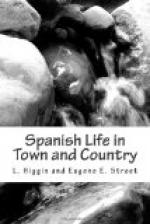The religious fiestas, as I have said, may be classed among the amusements of the people. During the warm season they invariably end with a bull-fight. In winter there are no bulls. Whether it be the Romeria of Santiago de Compostelo, the Santa Semana in Toledo or Seville, Noche-Buena and the Day of the Nativity in Madrid or Barcelona, gaiety and enjoyment seem to be the order of the day. Even Lent is not so bad, for just before it comes the Carnival and the grotesque “Burial of the Sardine” by the gente bajo, and of the three great masked balls, one is given in mid-Lent, to prevent the Lenten ordeal being too trying, and Holy Thursday is always a fiesta and day of enjoyment. On this day, in Madrid, takes place the washing of the feet of the poor in the Royal Palace—a function that savours a good deal of the ridiculous, but which was never omitted by the piadosa Isabel II., and was revived by her son. For forty-eight hours the bells of all the churches remain silent, no vehicles are allowed in the streets, which are gravelled along the routes Royalty will take to visit on foot seven of the churches, where the Holy Sepulchres are displayed; and in the afternoon all Madrid resorts to the Plaza del Sol and the Carrera San Geronimo, to show off their gayest costumes in a regular gala promenade. Finally, on Saturday morning—why forty-eight hours only is allowed for the supposed entombment does not quite appear—the bells clang forth, noise and gaiety pervade the whole city, and the day ends with a cock-fight and the reopening




